
During an interview with Bloomberg, Grayscale CEO Michael Sonnenshein said that in addition to hedge funds, pension funds and endowments had also started investing in the Grayscale family of products. This suggests that a broad spectrum of institutions are accumulating Bitcoin (BTC).
As this trend gathers speed, investment banks have also decided that they do not want to be left behind. A recent filing from Morgan Stanley shows a purchase of a 10.9% stake in business intelligence firm MicroStrategy, a move that was likely made in order to gain exposure in Bitcoin. With 70,470 Bitcoin in their possession, MicroStrategy has become a proxy play on Bitcoin.
Several analysts suspect that the current demand could also be coming from investors who have been closing their gold positions and buying Bitcoin. On a query about the recent underperformance of gold, CNBC Mad Money show host Jim Cramer speculated that institutional money may be flowing into cryptocurrency.
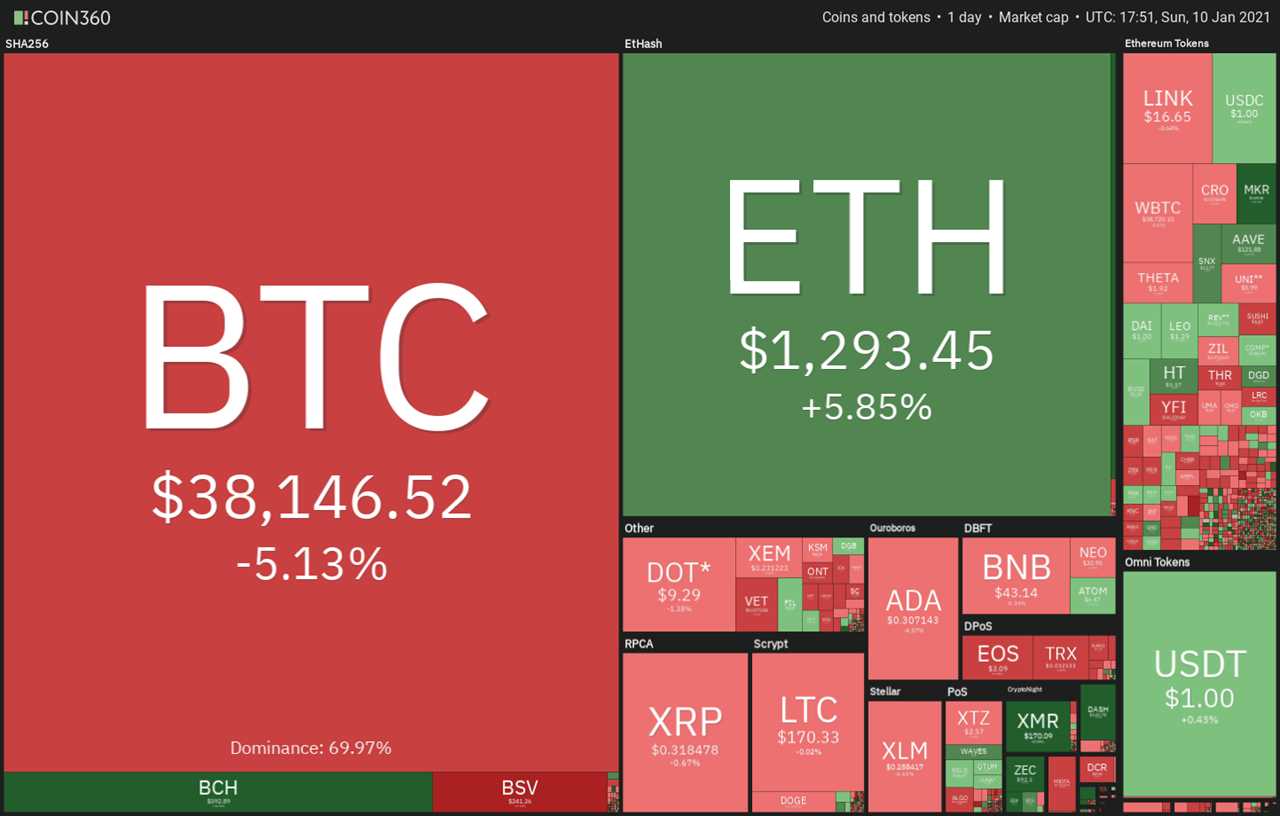
While there have been positive reports about institutional purchases, traders should also keep track of the people who have been selling because at some point the rally will lose momentum and investors will look to book profits.
Analysts at Material Indicators suggest that mega whales may have booked profits on Jan. 7 when Bitcoin hit $40,000 and further selling from whales could also be the reason for the price drop seen today. However, aggressive buying at lower levels resulted in a strong rebound.
But that has not deterred the whales from selling. Bitcoin whales in South Korea have been dumping their positions over the past few days, as seen from the multiple $100 million deposits to exchanges. While the selling has not caused a massive rush to the exit, traders should be careful with their positions because even if a couple of large investors in the U.S. rush to the exit, it could result in a sharp fall.
If Bitcoin corrects sharply, most altcoins are also likely to follow suit, but if Bitcoin remains strong, these top-5 cryptocurrencies could outperform in the short term.
Let’s analyze their charts to spot the critical levels to watch.
BTC/USD
Bitcoin has been in a strong uptrend for the past few weeks, but the rally has pushed the relative strength index (RSI) into overbought territory. While markets can remain overbought for a long time, with every rise, the risk of a sharp correction increases.
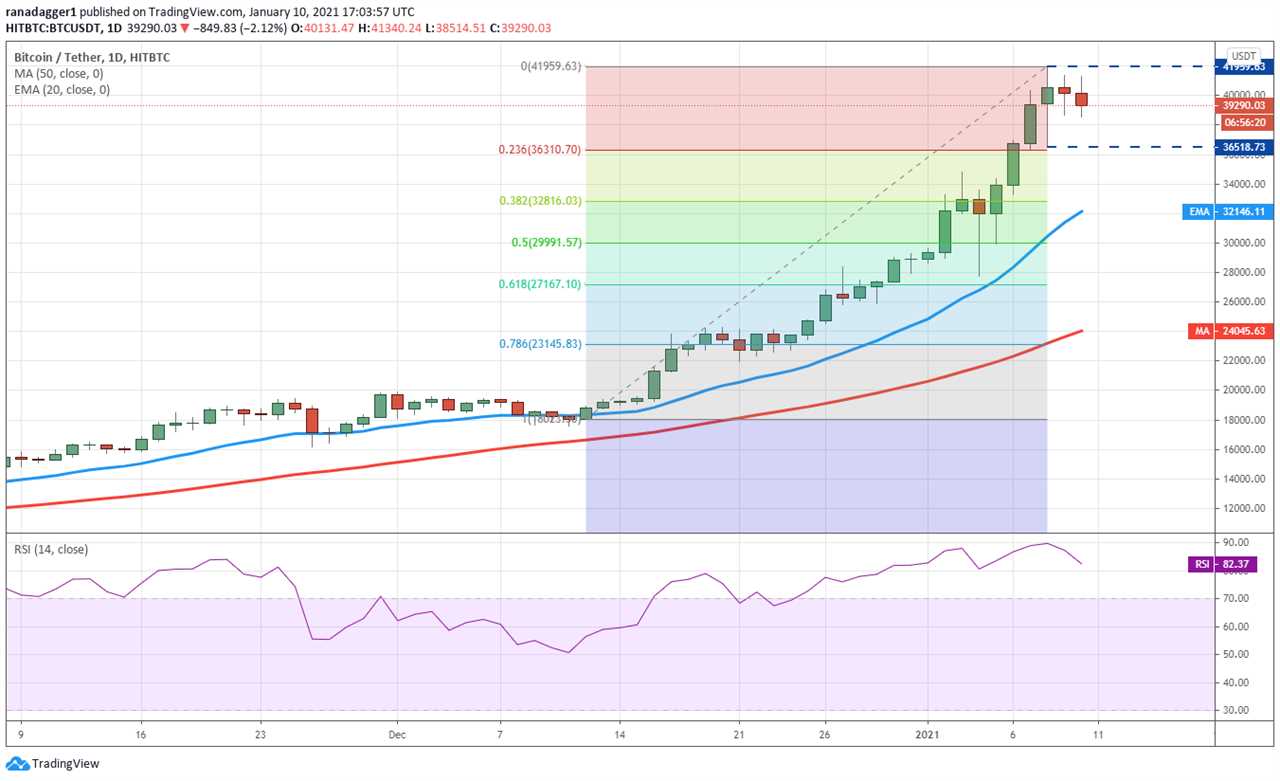
The first support on the downside is the intraday low made on Jan. 8 at $36,518.73. If the price rebounds off this level, it will suggest that traders are not booking profits in a hurry and are buying on minor dips.
If the bulls propel the price above $41,959.63, the uptrend could resume with the next target objective at $45,000 and then $50,000.
However, if the bears sink the price below $36,518.73, the BTC/USD pair could drop to the 38.2% Fibonacci retracement level of the most recent leg of the up-move at $32,816.03.
This is a crucial support to monitor because if it cracks, several traders may start to panic and dump their positions, which may result in a deeper correction to the 61.8% retracement level at $27,167.10.
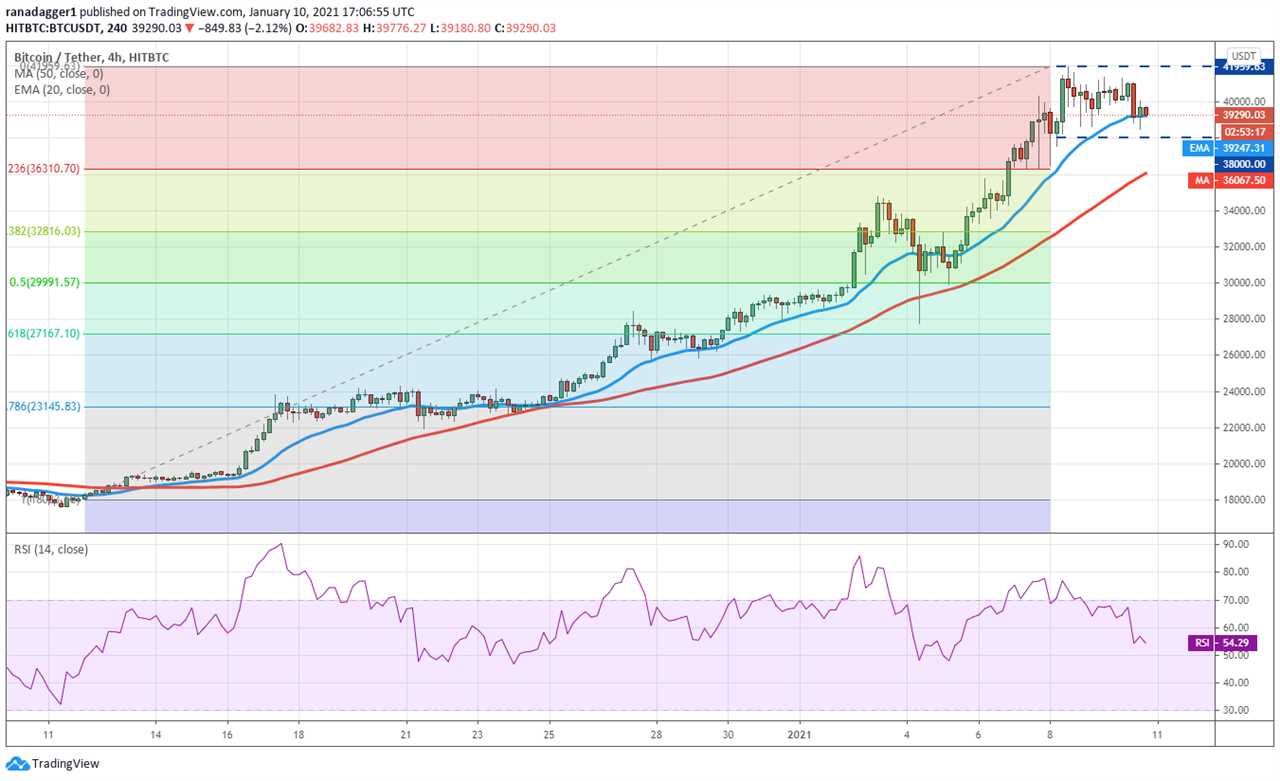
The 4-hour chart shows that the price is currently stuck inside a $38,000 to $41,959.63 range. If the bulls can push the price above the range, the uptrend may resume.
On the other hand, if the bears sink the price below the support of the range, it will suggest profit-booking by traders.
The next support on the downside is the 50-simple moving average, which has not been breached decisively during previous corrections in this leg of the uptrend. Thus, if this support cracks, it will signal a possible trend change.
ADA/USD
Cardano (ADA) is currently consolidating in an uptrend. The altcoin has been stuck between $0.2632811 and $0.3542857 for the past few days, which has pulled down the RSI from deeply overbought levels.
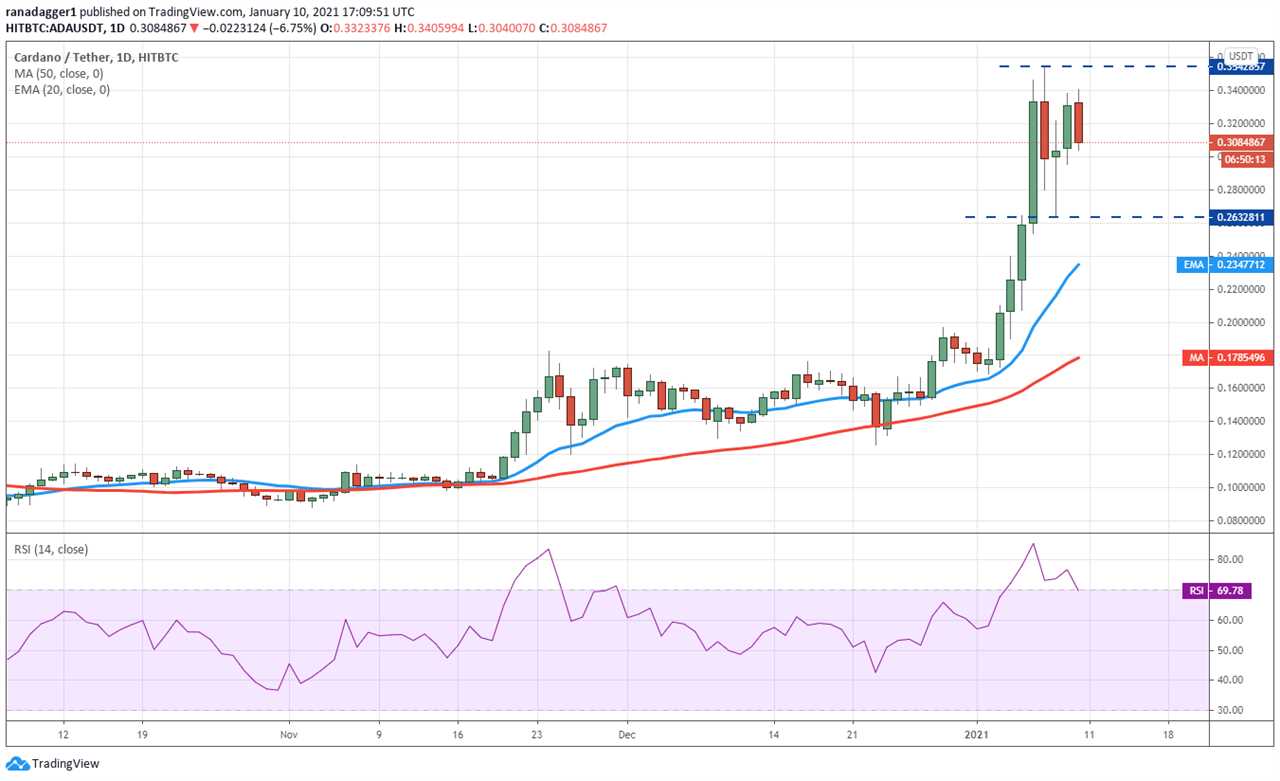
The bulls are currently facing stiff resistance near the $0.34 level but one positive sign is that there are no signs of panic selling yet. If the bulls can drive the price above the overhead resistance, the next leg of the uptrend could resume.
The ADA/USD pair has a target objective at $0.449 but the bears are likely to mount a stiff resistance near $0.40. However, if the bulls can push the price above the resistance levels, the pair could rally to the psychological level at $0.50.
This bullish view will be invalidated if the pair turns down and breaks below the 20-day EMA ($0.234). Such a move will suggest that the uptrend may have topped out.
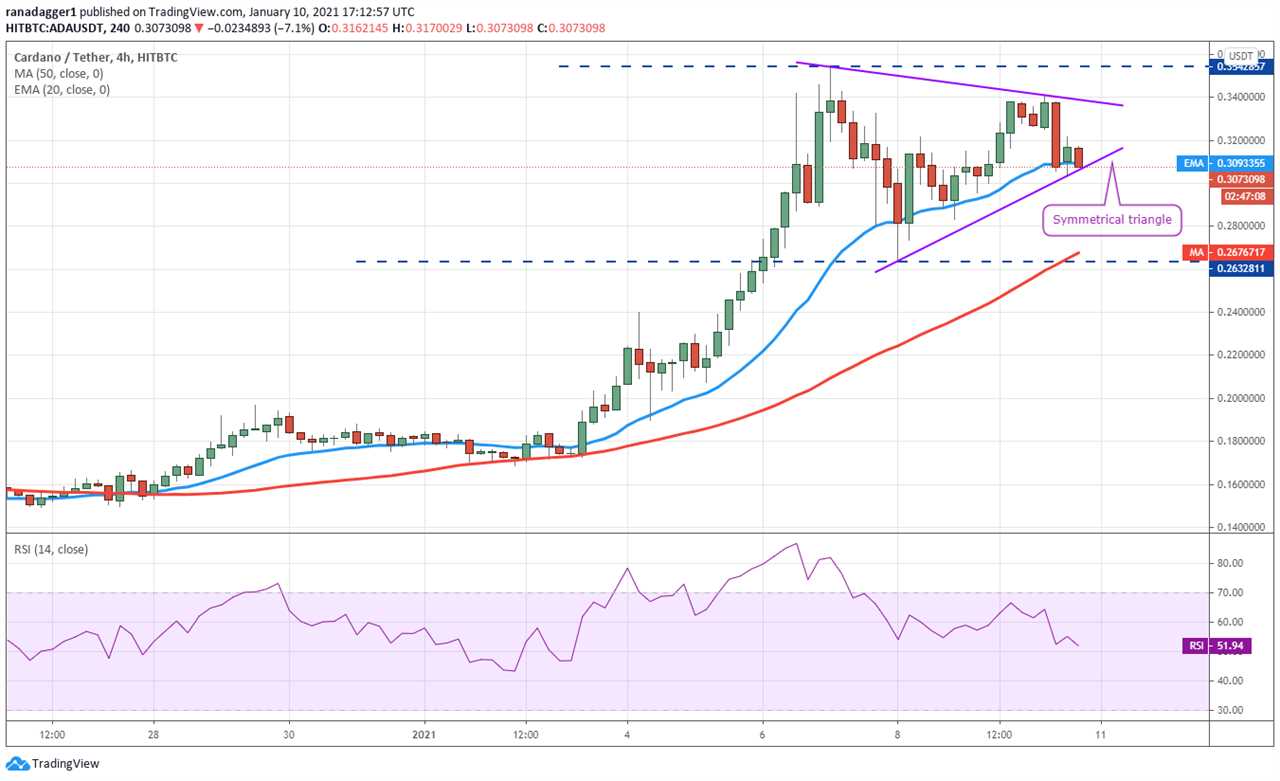
The 4-hour chart shows the formation of a symmetrical triangle, which usually acts as a continuation pattern. The bulls are currently attempting to defend the 20-EMA. If the price rebounds off the current levels, the bulls will try to push the pair above the triangle.
If they succeed, the pair may rally to $0.525. However, if the pair drops below the triangle, the next support is at the 50-SMA, but if this support also cracks, the decline could extend to $0.20.
EOS/USD
EOS has been trading inside a large range between $2.20 and $3.949. The altcoin turned down sharply from the overhead resistance today, which shows aggressive selling by the bears.
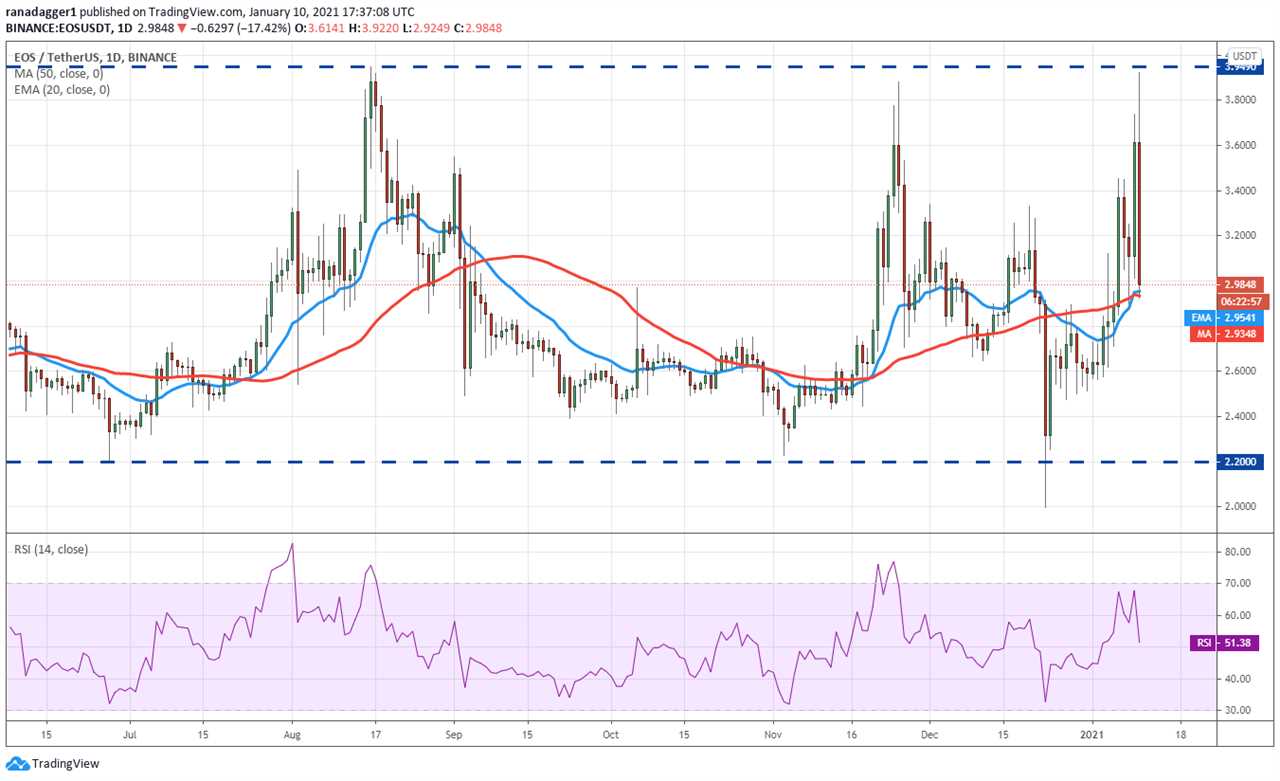
However, if the bulls defend the moving averages, the EOS/USD pair may again attempt to rise to the overhead resistance near $3.949. A breakout of this level will suggest the start of a new uptrend that may reach $5.698.
This view will be invalidated if the bears sink and sustain the price below the moving averages. Such a move could result in a fall to the support of the range at $2.20 and that may keep the pair range-bound for a few more days.
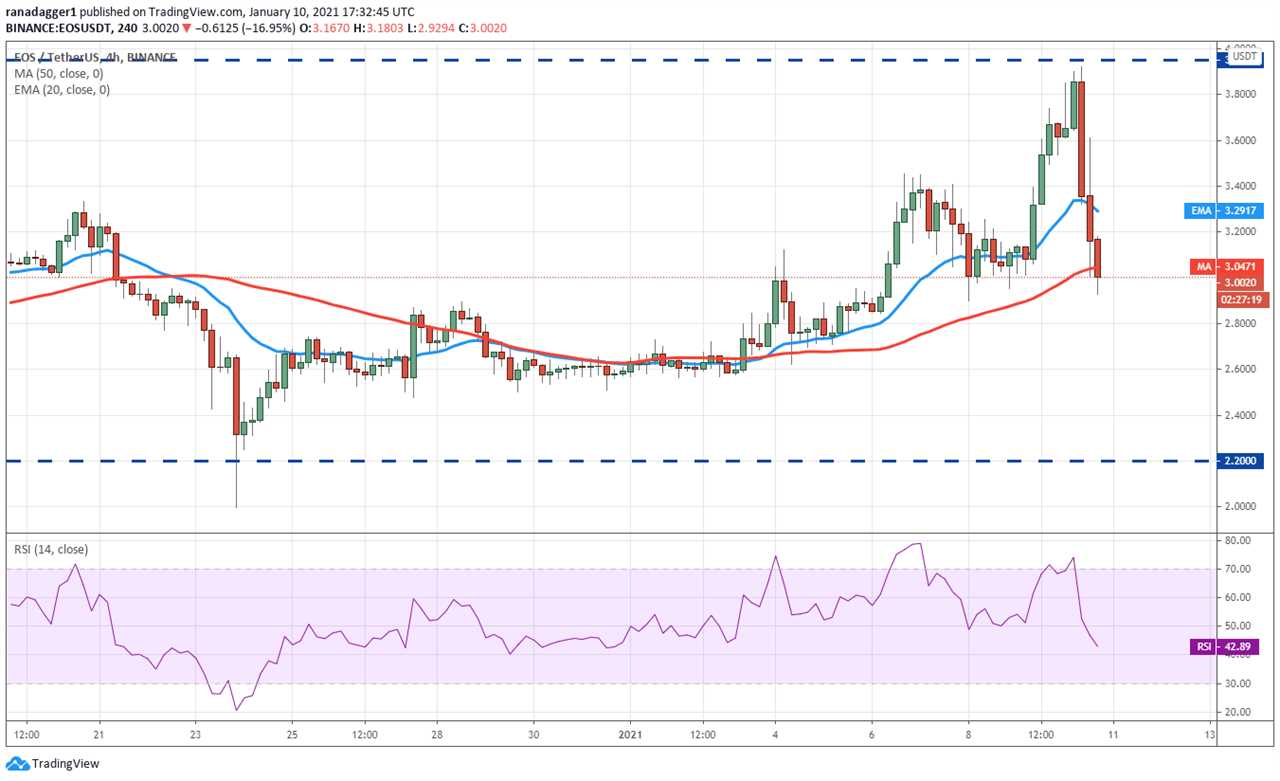
The 4-hour chart shows that the price turned down sharply from the overhead resistance and broke below both moving averages. This suggests aggressive selling by the bears.
However, if the price rebounds off the current level and rises above the 20-EMA, it will suggest that the selling may be over. The bulls may then again try to carry the price to the overhead resistance.
Conversely, if the bears sustain the price below $3, the pair may drop to $2.50 and then to $2.20.
THETA/USD
THETA is currently consolidating in an uptrend for the past few days. The price has been making lower highs, which suggests that every attempt to rally is being met with selling from the bears.
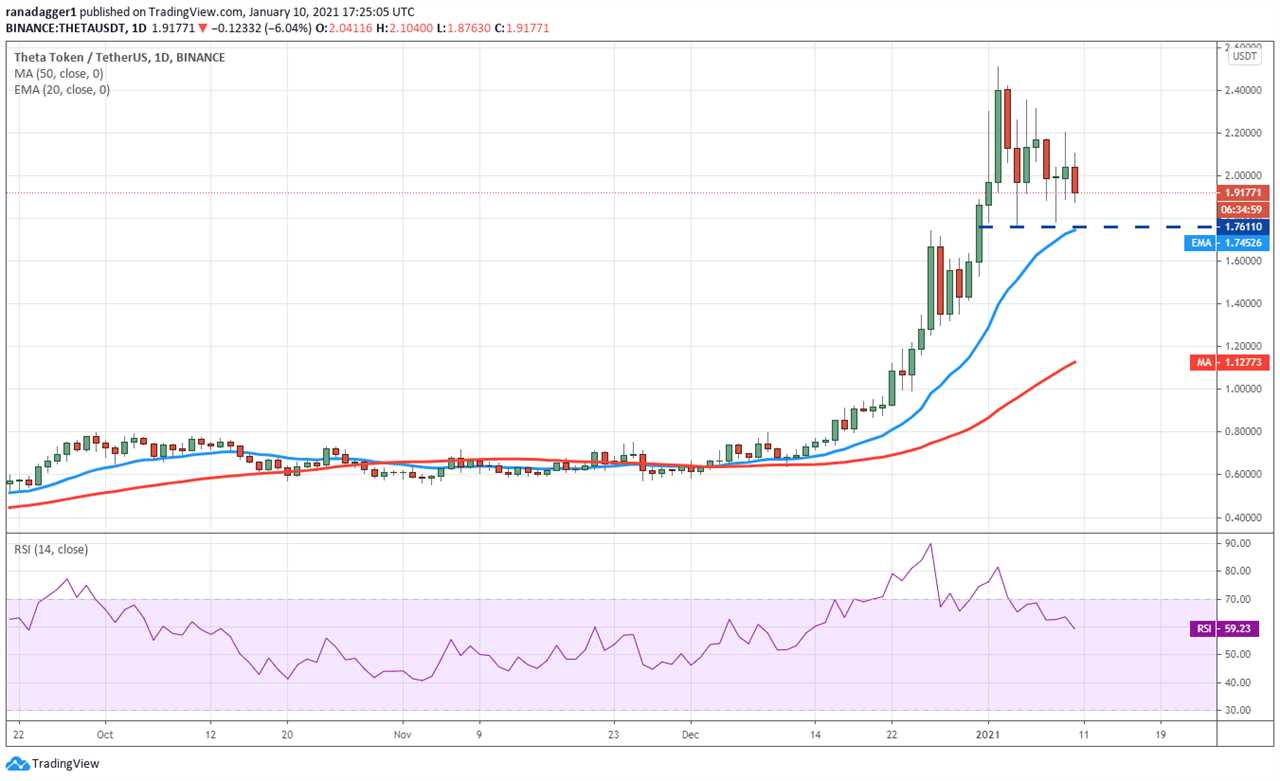
However, a minor positive is that the bulls have not allowed the price to dip below the $1.7611 support. The 20-day EMA ($1.74) is just below this level and the bulls are likely to defend it aggressively.
If the bulls can push the price above $2.20, the THETA/USD pair may rise to $2.51. The upsloping moving averages and the RSI in the positive territory suggest bulls are in control.
If the bears continue their selling and sink the pair below the 20-day EMA, it may open the gates for a drop to the 50-day SMA ($1.12).
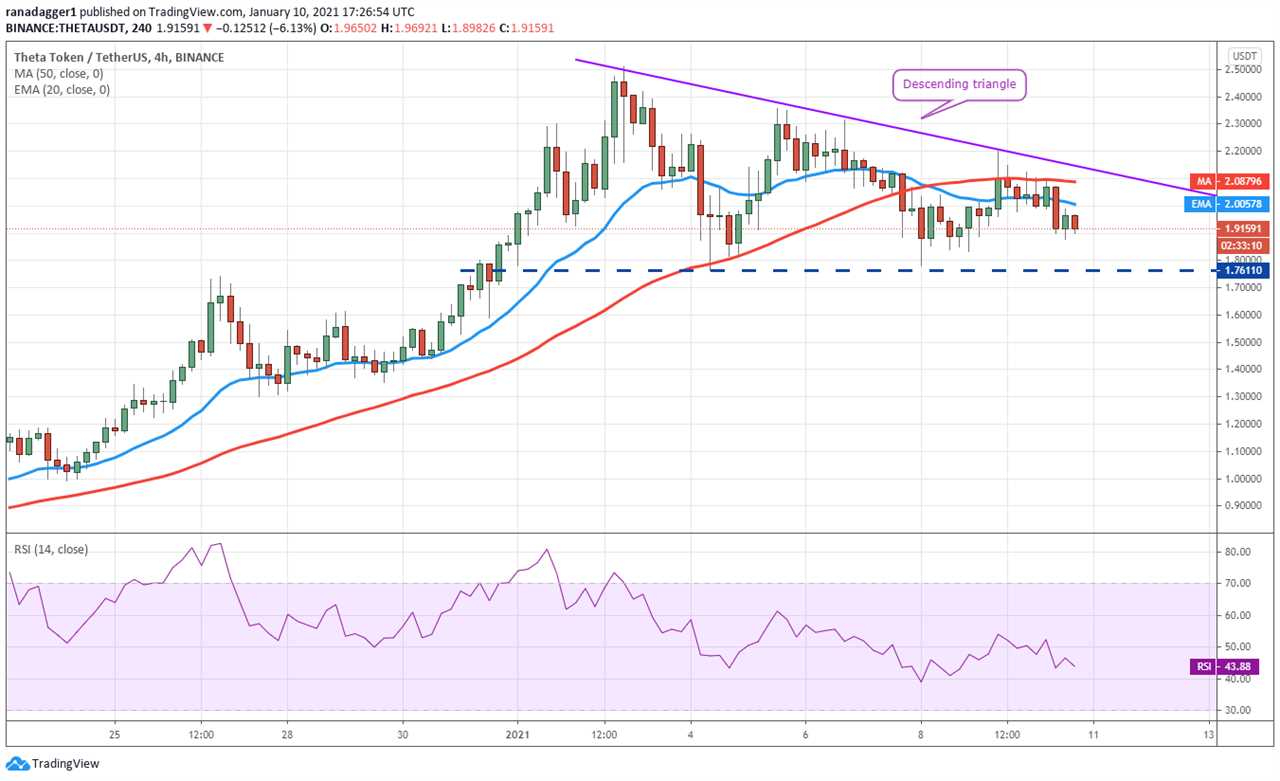
The 4-hour chart shows a descending triangle formation. The flat moving averages and the RSI just below the midpoint suggest a balance between supply and demand.
If the bears can sink and sustain the price below $1.7611, the descending triangle pattern will complete and that could drag the price down to $1.01.
On the other hand, if the bulls can push the price above the triangle, it will invalidate the bearish pattern. This could push the price to $2.51 and if the bulls can thrust the price above this resistance, the up-move could reach $2.95.
AAVE/USD
AAVE is currently in an uptrend as it continues to make higher highs and higher lows formation. However, the long wick on today’s candlestick shows that bears are aggressively selling at higher levels.
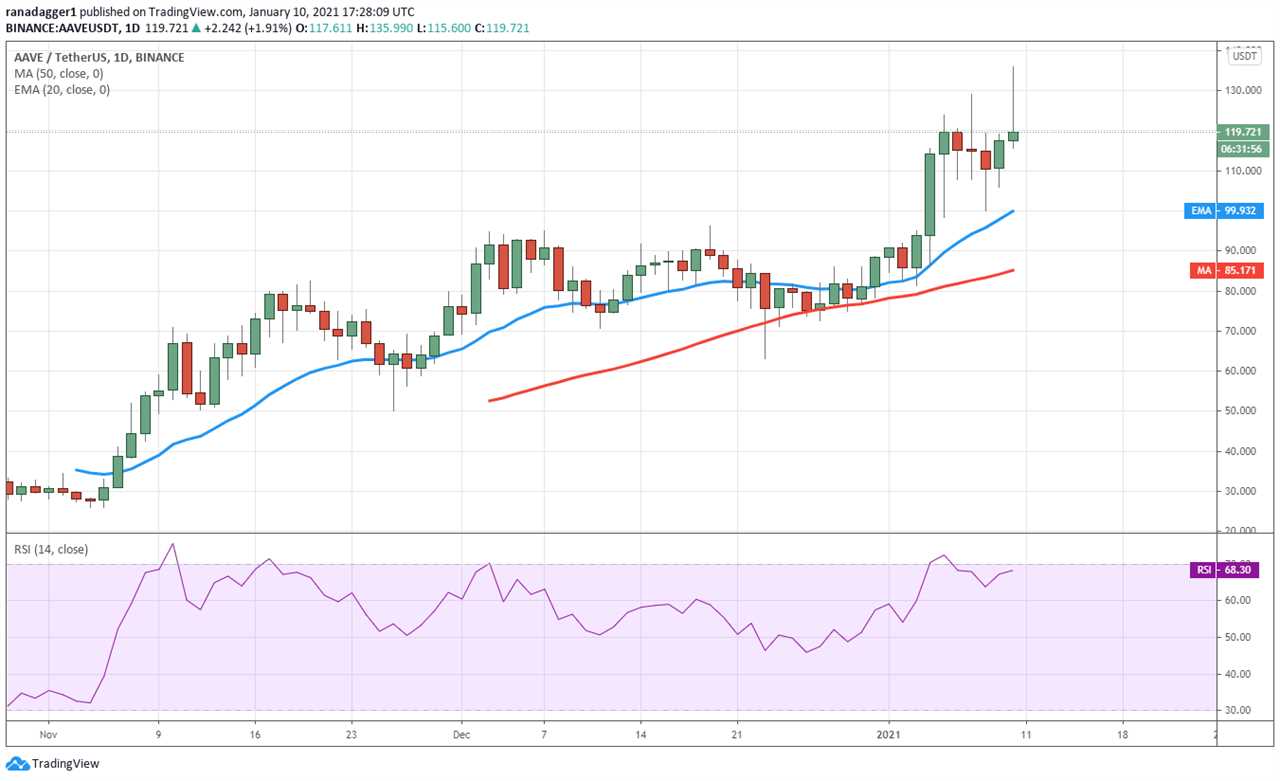
The upsloping moving averages and the RSI near overbought territory suggest the path of least resistance is to the upside. If the AAVE/USD pair corrects further, a rebound off the 20-day EMA ($99.93) will confirm that traders are continuing to buy on dips.
If the buyers can push the price above $135.99, the uptrend could resume with the next likely target at $150.
However, if the bears sink the price below the 20-day EMA, the pair could drop to the 50-day SMA ($85). A break below this support could result in a fall to $70 and then to $60.
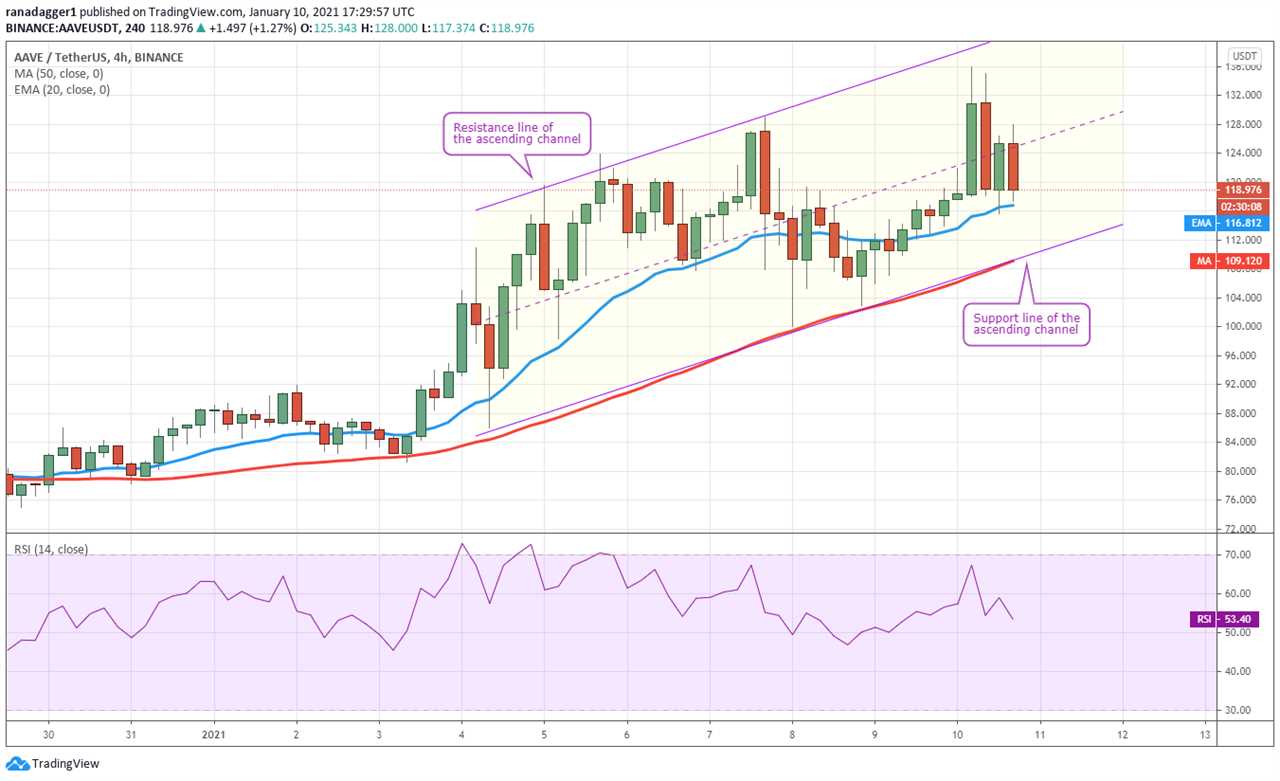
The 4-hour chart shows that the pair is trading inside an ascending channel. The bulls are currently attempting to defend the 20-EMA. A strong bounce could carry the price to the resistance line of the channel.
A break above the channel could result in a sharp up-move but if the price turns down from the resistance line of the channel, the pair may trade inside the channel for a few days.
If the price breaks below the 20-EMA, a drop to the support line of the channel is possible. A strong rebound off this support will keep the uptrend intact but a break below it could signal a trend change.
Title: Top 5 cryptocurrencies to watch this week: BTC, ADA, EOS, THETA, AAVE
Sourced From: cointelegraph.com/news/top-5-cryptocurrencies-to-watch-this-week-btc-ada-eos-theta-aave
Published Date: Sun, 10 Jan 2021 19:30:42 +0000






